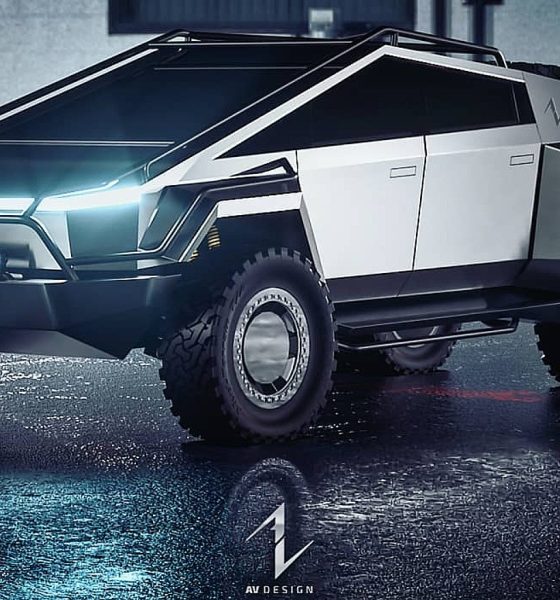

News
Elon Musk gets Governor’s welcome to build Tesla Cybertruck in Alaska
The Tesla Cybertruck may be polarizing, but it is a vehicle that has captured the interest of the motoring world and beyond. And while neither Tesla nor Elon Musk has announced any details about where the upcoming all-electric pickup truck would be produced, this has not deterred a government official from extending an offer to the CEO.
In a recent tweet, Alaska governor Governor Mike Dunleavy invited Tesla CEO Elon Musk to consider utilizing the state’s resources to build the electric car maker’s premium vehicles. The governor specifically mentioned the company’s recently-unveiled Cybertruck in his offer, stating that AK stands above other areas when it comes to balancing resource development.
“Hey @elonmusk & @Tesla: Let’s talk about utilizing #Alaska’s vast resources to help build #Tesla cars and the new Cybertruck. Nobody in the world balances resource development and environmental stewardship better than us,” he wrote.
Hey @elonmusk & @Tesla: Let’s talk about utilizing #Alaska’s vast resources to help build #Tesla cars and the new Cybertruck. Nobody in the world balances resource development and environmental stewardship better than us.— Governor Mike Dunleavy (@GovDunleavy) December 4, 2019
Dunleavy’s invitation is quite notable considering that the governor has reportedly maintained a controversial stance on climate action, a topic that Tesla CEO Elon Musk is very particular about. Over his tenure as Alaska’s governor, critics have argued that Dunleavy’s administration has done very little to combat climate change, as shown when he disbanded the state’s climate response task force just months after assuming office.
Neither Tesla nor Elon Musk has posted a response to the governor’s open invitation so far.
Yet, behind Dunleavy’s controversies with his administration, it is difficult to deny that Tesla and Elon Musk are now being perceived as a potential economic booster for areas where its facilities are located at. Reno, NV, for example, is seeing businesses come to the area due to the presence of Gigafactory 1. A facility that produces electric cars in Alaska will likely have the same effect.
What nobody saw was all the other businesses that moved to Reno just because Tesla was here. Tesla put Reno on the map, but now we're playing catchup. The paper reports apartment complexes waiting to be built for lack of skilled carpenters. Reno is a boomtown.— Carsonight (@carsonight) November 30, 2019
The Tesla Cybertruck is Tesla’s most radical creation to date. Built with a rigid ultra-strong stainless steel exoskeleton, the all-electric pickup truck is tough and capable of being put through serious punishment. This is something that was highlighted by auto veteran Jack Rickard in a discussion on YouTube’s EVTV channel. Rickard noted that the Cybertruck’s polarizing design was not just put in place to make the vehicle unique; it is also functional.
Thanks to its polarizing XY design, the Cybertruck will not require a stamping press or a paint shop. This makes the vehicle easy to make, and this opens up the potential of a production line that is more compact and efficient than those adopted by the company for its previous cars like the Model 3. With this in mind, Tesla may be able to produce the Cybertruck in facilities that are not as expansive as the Fremont factory of Gigafactory 3 in Shanghai. This, of course, could accelerate the rollout of Elon Musk’s boldest, most futuristic vehicle to date.

News
Tesla (TSLA) receives “Buy” rating and $551 PT from Canaccord Genuity
He also maintained a “Buy” rating for TSLA stock over the company’s improving long-term outlook, which is driven by autonomy and robotics.

Canaccord Genuity analyst George Gianarikas raised his Tesla (NASDAQ:TSLA) price target from $482 to $551. He also maintained a “Buy” rating for TSLA stock over the company’s improving long-term outlook, which is driven by autonomy and robotics.
The analyst’s updated note
Gianarikas lowered his 4Q25 delivery estimates but pointed to several positive factors in the Tesla story. He noted that EV adoption in emerging markets is gaining pace, and progress in FSD and the Robotaxi rollout in 2026 represent major upside drivers. Further progress in the Optimus program next year could also add more momentum for the electric vehicle maker.
“Overall, yes, 4Q25 delivery expectations are being revised lower. However, the reset in the US EV market is laying the groundwork for a more durable and attractive long-term demand environment.
“At the same time, EV penetration in emerging markets is accelerating, reinforcing Tesla’s potential multi‑year growth runway beyond the US. Global progress in FSD and the anticipated rollout of a larger robotaxi fleet in 2026 are increasingly important components of the Tesla equity story and could provide sentiment tailwinds,” the analyst wrote.
Tesla’s busy 2026
The upcoming year would be a busy one for Tesla, considering the company’s plans and targets. The autonomous two-seat Cybercab has been confirmed to start production sometime in Q2 2026, as per Elon Musk during the 2025 Annual Shareholder Meeting.
Apart from this, Tesla is also expected to unveil the next-generation Roadster on April 1, 2026. Tesla is also expected to start high-volume production of the Tesla Semi in Nevada next year.
Apart from vehicle launches, Tesla has expressed its intentions to significantly ramp the rollout of FSD to several regions worldwide, such as Europe. Plans are also underway to launch more Robotaxi networks in several more key areas across the United States.
News
Waymo sues Santa Monica over order to halt overnight charging sessions
In its complaint, Waymo argued that its self-driving cars’ operations do not constitute a public nuisance, and compliance with the city’s order would cause the company irreparable harm.

Waymo has filed a lawsuit against the City of Santa Monica in Los Angeles County Superior Court, seeking to block an order that requires the company to cease overnight charging at two facilities.
In its complaint, Waymo argued that its self-driving cars’ operations do not constitute a public nuisance, and compliance with the city’s order would cause the company irreparable harm.
Nuisance claims
As noted in a report from the Los Angeles Times, Waymo’s two charging sites at Euclid Street and Broadway have operated for about a year, supporting the company’s growing fleet with round-the-clock activity. Unfortunately, this has also resulted in residents in the area reportedly being unable to sleep due to incessant beeping from self-driving taxis that are moving in and out of the charging stations around the clock.
Frustrated residents have protested against the Waymos by blocking the vehicles’ paths, placing cones, and “stacking” cars to create backups. This has also resulted in multiple calls to the police.
Last month, the city issued an order to Waymo and its charging partner, Voltera, to cease overnight operations at the charging locations, stating that the self-driving vehicles’ activities at night were a public nuisance. A December 15 meeting yielded no agreement on mitigations like software rerouting. Waymo proposed changes, but the city reportedly insisted that nothing would satisfy the irate residents.
“We are disappointed that the City has chosen an adversarial path over a collaborative one. The City’s position has been to insist that no actions taken or proposed by Waymo would satisfy the complaining neighbors and therefore must be deemed insufficient,” a Waymo spokesperson stated.
Waymo pushes back
In its legal complaint, Waymo stated that its “activities at the Broadway Facilities do not constitute a public nuisance.” The company also noted that it “faces imminent and irreparable harm to its operations, employees, and customers” from the city’s order. The suit also stated that the city was fully aware that the Voltera charging sites would be operating around the clock to support Waymo’s self-driving taxis.
The company highlighted over one million trips in Santa Monica since launch, with more than 50,000 rides starting or ending there in November alone. Waymo also criticized the city for adopting a contentious strategy against businesses.
“The City of Santa Monica’s recent actions are inconsistent with its stated goal of attracting investment. At a time when the City faces a serious fiscal crisis, officials are choosing to obstruct properly permitted investment rather than fostering a ‘ready for business’ environment,” Waymo stated.
News
Tesla FSD v14.2.2 is getting rave reviews from drivers
So far, early testers have reported buttery-smooth drives with confident performance, even at night or on twisty roads.

Tesla Full Self-Driving (Supervised) v14.2.2 is receiving positive reviews from owners, with several drivers praising the build’s lack of hesitation during lane changes and its smoother decision-making, among others.
The update, which started rolling out on Monday, also adds features like dynamic arrival pin adjustment. So far, early testers have reported buttery-smooth drives with confident performance, even at night or on twisty roads.
Owners highlight major improvements
Longtime Tesla owner and FSD user @BLKMDL3 shared a detailed 10-hour impression of FSD v14.2.2, noting that the system exhibited “zero lane change hesitation” and “extremely refined” lane choices. He praised Mad Max mode’s performance, stellar parking in locations including ticket dispensers, and impressive canyon runs even in dark conditions.
Fellow FSD user Dan Burkland reported an hour of FSD v14.2.2’s nighttime driving with “zero hesitations” and “buttery smooth” confidence reminiscent of Robotaxi rides in areas such as Austin, Texas. Veteran FSD user Whole Mars Catalog also demonstrated voice navigation via Grok, while Tesla owner Devin Olsen completed a nearly two-hour drive with FSD v14.2.2 in heavy traffic and rain with strong performance.
Closer to unsupervised
FSD has been receiving rave reviews, even from Tesla’s competitors. Xpeng CEO He Xiaopeng, for one, offered fresh praise for FSD v14.2 after visiting Silicon Valley. Following extended test drives of Tesla vehicles running the latest FSD software, He stated that the system has made major strides, reinforcing his view that Tesla’s approach to autonomy is indeed the proper path towards autonomy.
According to He, Tesla’s FSD has evolved from a smooth Level 2 advanced driver assistance system into what he described as a “near-Level 4” experience in terms of capabilities. While acknowledging that areas of improvement are still present, the Xpeng CEO stated that FSD’s current iteration significantly surpasses last year’s capabilities. He also reiterated his belief that Tesla’s strategy of using the same autonomous software and hardware architecture across private vehicles and robotaxis is the right long-term approach, as it would allow users to bypass intermediate autonomy stages and move closer to Level 4 functionality.








